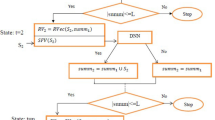Abstract
Text summarization is an essential task in natural language processing, and researchers have developed various approaches over the years, ranging from rule-based systems to neural networks. However, there is no single model or approach that performs well on every type of text. We propose a system that recommends the most suitable summarization model for a given text. The proposed system employs a fully connected neural network that analyzes the input content and predicts which summarizer should score the best in terms of ROUGE score for a given input. The meta-model selects among four different summarization models, developed for the Slovene language, using different properties of the input, in particular its Doc2Vec document representation. The four Slovene summarization models deal with different challenges associated with text summarization in a less-resourced language. We evaluate the proposed SloMetaSum model performance automatically and parts of it manually. The results show that the system successfully automates the step of manually selecting the best model.
Access this chapter
Tax calculation will be finalised at checkout
Purchases are for personal use only
Similar content being viewed by others
Notes
- 1.
Within the scope of the RSDO project: https://www.cjvt.si/rsdo/.
- 2.
The demo is available at https://slovenscina.eu/en/povzemanje. The code repositories are available at https://github.com/azagsam/metamodel and https://github.com/clarinsi/SloSummarizer.
- 3.
References
Brown, T.B., et al.: Language models are few-shot learners. arXiv preprint arXiv:2005.14165 (2020)
Bučar, J.: Automatically sentiment annotated Slovenian news corpus AutoSentiNews 1.0 (2017). http://hdl.handle.net/11356/1109. Slovenian language resource repository CLARIN.SI
Erkan, G., Radev, D.R.: LexRank: graph-based lexical centrality as salience in text summarization. J. Artif. Intell. Res. 22, 457–479 (2004)
Feng, F., Yang, Y., Cer, D., Arivazhagan, N., Wang, W.: Language-agnostic BERT sentence embedding. In: Proceedings of the 60th Annual Meeting of the Association for Computational Linguistics (Volume 1: Long Papers), pp. 878–891 (2022)
Hermann, K.M., et al.: Teaching machines to read and comprehend. In: Advances in Neural Information Processing Systems, vol. 28 (2015)
Knight, K., Marcu, D.: Summarization beyond sentence extraction: a probabilistic approach to sentence compression. Artif. Intell. 139(1), 91–107 (2002)
Le, Q., Mikolov, T.: Distributed representations of sentences and documents. In: International Conference on Machine Learning, pp. 1188–1196. PMLR (2014)
Lebar Bajec, I., Repar, A., Bajec, M., Bajec, Ž., Rizvič, M.: NeMo neural machine translation service RSDO-DS4-NMT-API 1.0 (2022). http://hdl.handle.net/11356/1739. Slovenian language resource repository CLARIN.SI
Lewis, M., et al.: BART: denoising sequence-to-sequence pre-training for natural language generation, translation, and comprehension. In: Proceedings of the 58th Annual Meeting of the Association for Computational Linguistics, pp. 7871–7880 (2020)
Mihalcea, R., Tarau, P.: TextRank: bringing order into text. In: Proceedings of the 2004 Conference on Empirical Methods in Natural Language Processing, pp. 404–411 (2004)
Nallapati, R., Zhou, B., dos Santos, C., Gulçehre, Ç., Xiang, B.: Abstractive text summarization using sequence-to-sequence RNNs and beyond. In: Proceedings of the 20th SIGNLL Conference on Computational Natural Language Learning, pp. 280–290 (2016)
Nenkova, A., Vanderwende, L.: The impact of frequency on summarization. Technical report, Microsoft Research (2005)
Raffel, C., et al.: Exploring the limits of transfer learning with a unified text-to-text transformer. J. Mach. Learn. Res. 21(140), 1–67 (2020)
See, A., Liu, P.J., Manning, C.D.: Get to the point: summarization with pointer-generator networks. In: Proceedings of the 55th Annual Meeting of the Association for Computational Linguistics (Volume 1: Long Papers), pp. 1073–1083 (2017)
Ulčar, M., Robnik-Šikonja, M.: Sequence to sequence pretraining for a less-resourced Slovenian language. arXiv preprint arXiv:2207.13988 (2022)
Žagar, A., et al.: Corpus of academic Slovene KAS 2.0 (2022). http://hdl.handle.net/11356/1448. Slovenian language resource repository CLARIN.SI
Žagar, A., Robnik-Šikonja, M.: Unsupervised approach to multilingual user comments summarization. In: Proceedings of the EACL Hackashop on News Media Content Analysis and Automated Report Generation, pp. 89–98. Association for Computational Linguistics (2021)
Zhang, J., Zhao, Y., Saleh, M., Liu, P.: Pegasus: pre-training with extracted gap-sentences for abstractive summarization. In: International Conference on Machine Learning, pp. 11328–11339. PMLR (2020)
Acknowledgments
The work was partially supported by the Slovenian Research Agency (ARRS) core research programme P6-0411, as well as projects J6-2581, J7-3159, and CRP V5-2297.
Author information
Authors and Affiliations
Corresponding author
Editor information
Editors and Affiliations
Rights and permissions
Copyright information
© 2023 The Author(s), under exclusive license to Springer Nature Switzerland AG
About this paper
Cite this paper
Žagar, A., Robnik-Šikonja, M. (2023). One Model to Rule Them All: Ranking Slovene Summarizers. In: Ekštein, K., Pártl, F., Konopík, M. (eds) Text, Speech, and Dialogue. TSD 2023. Lecture Notes in Computer Science(), vol 14102. Springer, Cham. https://doi.org/10.1007/978-3-031-40498-6_2
Download citation
DOI: https://doi.org/10.1007/978-3-031-40498-6_2
Published:
Publisher Name: Springer, Cham
Print ISBN: 978-3-031-40497-9
Online ISBN: 978-3-031-40498-6
eBook Packages: Computer ScienceComputer Science (R0)




